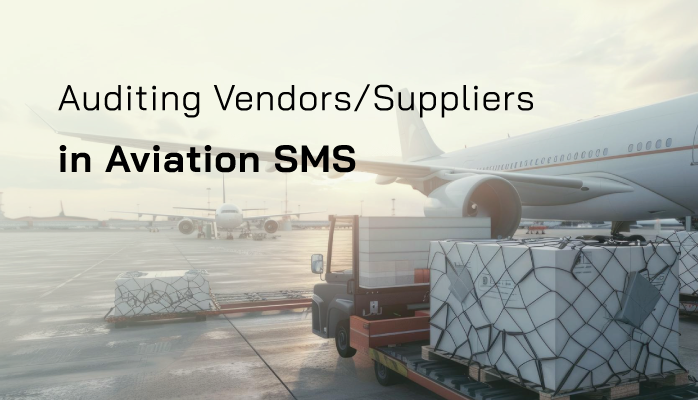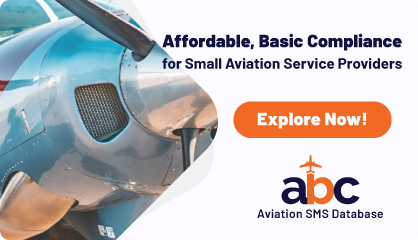Auditing Vendors/Suppliers

Aviation operations worldwide depend on vendors for critical services, from aircraft maintenance in global hubs to fueling in remote airstrips, making their alignment with Safety Management Systems (SMS) through auditing a cornerstone of safety.
Vendor audits systematically evaluate suppliers’ safety practices, ensuring they meet SMS standards and mitigate risks that could lead to incidents. For aviation safety managers, auditing vendors is not just a regulatory requirement but a strategic tool to foster a unified safety culture across diverse operations.
This article offers a comprehensive, global perspective on auditing vendors/suppliers in aviation SMS, exploring regulatory drivers, benefits, challenges, best practices, and real-world examples. It provides actionable insights for aviation safety managers to strengthen safety in varied contexts, from high-traffic airports to challenging environments like Alaska.
Related Articles on Vendors/Suppliers in Aviation SMS
- Performing Vendor Safety Assessments for Aviation SMS
- Why Include Vendors in Aviation Safety Management Systems (SMS)?
- Real Difference Between an Aviation Safety Audit vs. Inspection
The Role of Vendor Audits in Aviation Safety Management Systems
Vendor audits are structured assessments that verify suppliers’ compliance with SMS requirements, ensuring their practices align with an organization’s safety objectives. Vendors perform safety-critical tasks that directly impact aviation outcomes:
-
Maintenance Vendors: Conduct repairs and inspections to ensure aircraft airworthiness, from sophisticated facilities in Asia to smaller workshops in South America.
-
Fueling Vendors: Manage fuel safety, handling hazardous materials in diverse climates, from tropical regions to Arctic airports.
-
Ground Handling Vendors: Oversee ramp operations, baggage handling, and aircraft marshaling in both metropolitan hubs and remote airstrips.
-
Catering and Cleaning Vendors: Maintain cabin hygiene and safety standards, essential across all operations.
-
Training and Consulting Vendors: Provide expertise to enhance crew and staff safety competencies, critical in every aviation market.
Without regular audits, misaligned vendor practices can lead to serious incidents, such as maintenance errors causing system failures or fueling mishaps resulting in contamination.
According to SKYbrary, SMS must include oversight of third-party activities to effectively mitigate risks. In regions like Alaska, where harsh weather and remote operations amplify risks, audits are particularly vital to ensure vendors adhere to safety protocols for tasks like de-icing or fueling. Globally, vendor audits bridge gaps between operators and suppliers, fostering a cohesive safety ecosystem that prevents errors and enhances reliability.
Regulatory Drivers for Vendor Auditing

Global and regional aviation standards mandate vendor oversight within SMS, providing a universal framework for audits:
-
ICAO Annex 19: The International Civil Aviation Organization requires SMS to encompass all safety-critical activities, including contracted services. Section 3.3.2.3 emphasizes that organizations must ensure third-party providers meet safety standards, a principle adopted by all member states (ICAO).
-
Regional Regulatory Alignment: Authorities like the FAA (U.S.), EASA (Europe), CASA (Australia), and CAAC (China) align with ICAO, mandating audits of third-party providers. For example, FAA Advisory Circular 120-92B encourages operators to extend SMS oversight to vendors, while EASA’s Part-M and Part-145 focus on airworthiness audits (FAA, EASA).
-
Universal Compliance Standard: Regardless of jurisdiction, regulators expect operators to conduct regular vendor audits to verify safety compliance, making auditing a global necessity.
These frameworks establish vendor audits as a critical component of aviation safety. In established markets like Europe, EASA’s stringent requirements ensure vendors are audited for airworthiness, while in emerging markets like India, regulators emphasize audits to support rapid aviation growth. This universal approach ensures safety consistency, whether in a developed hub or a remote operation, reinforcing the importance of audits for aviation safety managers worldwide.
Related Aviation Safety Audit Articles
- Aviation Safety Audits 101: Prep and Pass - With Examples and Checklists
- How to Create an Aviation SMS Audit Plan
- 4 Tips for Passing Aviation SMS Audits - With Free Resources
Benefits of Auditing Vendors in Aviation SMS
Auditing vendors within aviation SMS delivers enduring, universal benefits that enhance safety, compliance, and operational efficiency across global aviation:
-
Improved Regulatory Compliance: Audits verify that vendors adhere to international and regional regulations, reducing the risk of audit failures during inspections by authorities like the FAA or EASA.
-
Proactive Risk Mitigation: Identifying weaknesses in vendor practices, such as inadequate maintenance procedures, prevents potential incidents before they occur.
-
Stronger Vendor Relationships: Collaborative audits build trust and mutual commitment to safety, fostering long-term partnerships with suppliers.
-
Enhanced Safety Culture: Audits reinforce shared safety values, encouraging vendors to prioritize safety in their operations, from major hubs to remote regions.
-
Data-Driven Safety Insights: Audit findings provide valuable data for SMS analytics, enabling operators to identify trends and implement targeted safety improvements.
Research from NBAA highlights that organizations with robust vendor audit programs experience fewer safety incidents, a benefit applicable across aviation sectors. In high-traffic hubs, audits reduce ramp incidents by ensuring consistent ground handling practices, while in remote areas they ensure reliable fueling under challenging conditions. These benefits create a resilient safety ecosystem, adaptable to any global context.
Challenges of Auditing Vendors in Aviation SMS
While the benefits of vendor auditing are universal, several challenges require careful navigation:
-
Resource Constraints: Small operators, whether in developed or emerging markets, may lack the budget or personnel to conduct thorough audits. For example, a regional operator in Africa or a small Alaskan carrier may face financial limitations.
-
Diverse Vendor Capabilities: Vendors range from sophisticated providers with mature SMS in major hubs to smaller firms with limited safety expertise in remote areas, complicating audit standardization.
-
Cultural Variations: Differing safety priorities across cultures can hinder alignment. Some vendors may prioritize cost over safety, requiring cultural sensitivity to align practices.
-
Cross-Border Coordination: Auditing vendors across multiple countries involves navigating language barriers, time zones, and varying regulatory requirements, adding complexity for global operators.
These challenges, while context-specific, can be addressed with scalable, timeless strategies that ensure effective audits in diverse operational environments, from urban hubs to remote airstrips.
Related Aviation Safety Audit Articles
- SRM-SA Aviation SMS Audit Preparation - 4 Free Checklist Templates
- How to Conduct Internal SMS Audits in Aviation Industry
- How to Audit Previously Managed Safety Issues in Aviation SMS
Best Practices for Auditing Vendors

Aviation safety managers can adopt enduring, globally applicable best practices to conduct effective vendor audits within their aviation SMS:
-
Develop Standardized Audit Checklists: Create universal templates that cover key SMS components, such as hazard reporting and compliance, while allowing customization for local regulations or vendor roles. SMS Pro offers sample industry-accepted audit checklists adaptable to various contexts.
-
Schedule Regular Audits: Conduct periodic audits, adjusting frequency based on vendor risk profiles (e.g., more frequent for high-risk tasks like maintenance). A quarterly or annual schedule ensures consistency.
-
Engage in Collaborative Audits: Involve vendors in the audit process, sharing objectives and expectations to build trust and encourage proactive compliance.
-
Provide Training Support: Offer SMS training to vendors, particularly those with limited safety expertise, to align their practices with organizational standards. Training can be tailored to address regional risks, like extreme weather in Arctic areas.
-
Integrate Audit Data into SMS Database: Use audit findings to enhance SMS analytics, identifying trends like recurring maintenance issues to inform risk management strategies.
-
Communicate Findings Clearly: Share audit results and corrective actions transparently with vendors, fostering a collaborative approach to addressing deficiencies.
-
Recognize Compliance and Excellence: Reward vendors for strong safety performance through certifications, incentives, or public acknowledgment, motivating continued adherence in diverse cultural contexts.
-
Leverage Technology: Use digital audit tools, such as cloud-based SMS software, to streamline data collection and reporting, ensuring accessibility across regions and time zones.
-
Adapt to Local Contexts: Tailor audit approaches to regional needs, such as providing multilingual audit materials in diverse markets or focusing on environmental risks in regions like Alaska and northern Canada.
These practices are designed to remain relevant across time, applicable in high-traffic hubs, remote regions, or emerging aviation markets. Adopting SMS software becomes more important within remote regions as trained employees become much harder to find.
Related Aviation SMS Software Articles
- How to Choose Aviation SMS Software - Educating SMS Professionals
- Spreadsheets vs Software for Aviation Safety Management
- 20 Benefits of Aviation SMS Software
Case Studies: Global Lessons in Vendor Auditing
Case Study 1: Maintenance Vendor Audit Failure
A regional airline in a developed aviation market experienced a near-miss incident when a maintenance vendor failed to comply with airworthiness protocols, resulting in an in-flight system malfunction. The investigation revealed:
- Lack of SMS Audit Oversight: The vendor was not regularly audited, leading to inconsistent maintenance practices.
- Communication Breakdown: No formal channel existed for sharing safety concerns, delaying issue identification.
- Resolution: The airline implemented quarterly audits, joint training, and a digital reporting platform, preventing recurrence.
This case highlights the risks of inadequate vendor audits, a lesson applicable in any region where maintenance outsourcing is common, from North America to Southeast Asia.
Case Study 2: Successful Ground Handling Audit Program
An international airport operator in a major hub reduced ramp incidents by implementing a robust audit program for ground handling vendors. Key actions included:
- Standardized Checklists: Developed universal ramp safety checklists, adopted by all vendors to ensure consistency.
- Collaborative Audits: Involved vendors in audit planning, fostering trust and compliance.
- Data-Driven Improvements: Integrated audit findings into SMS analytics, enabling proactive risk management.
The initiative significantly reduced ramp incidents, offering a replicable model for high-traffic environments worldwide, from Dubai to London.
Case Study 3: Fueling Vendor Audit in a Remote Region
A regional operator in a remote, weather-challenged area improved fueling safety through a targeted vendor audit program. Actions included:
- Specialized Audits: Focused on fuel handling protocols tailored to extreme environmental conditions.
- Training Support: Provided training on SMS compliance, addressing local risks like cold-weather fueling errors.
- Real-Time Reporting: Implemented a digital system for vendors to report hazards instantly.
The result was a marked decrease in fueling errors, demonstrating the value of audits in challenging environments, applicable to remote regions globally, including Alaska.
Global Perspective: Adapting Audits to Diverse Contexts

Aviation safety managers must adapt vendor audit strategies to varied global contexts while maintaining universal principles:
-
High-Traffic Hubs: In hubs like Singapore or Frankfurt, focus on coordinating audits for multiple vendors with advanced SMS capabilities, ensuring seamless operations in complex environments.
-
Remote Regions: In areas like the Arctic, rural Africa, or Alaska, prioritize training and communication during audits to address logistical and environmental challenges, such as extreme weather or limited infrastructure.
-
Emerging Markets: In growing sectors like India, Brazil, or Southeast Asia, support vendors in building SMS capacity through audit guidance, simplified checklists, and mentorship.
-
Mixed Operations: For operators with global reach, standardize audit frameworks while allowing flexibility for local adaptations, ensuring consistency across diverse vendor networks.
By applying these timeless practices, managers can achieve consistent safety outcomes, whether auditing vendors in a single region or across multiple continents. In Alaska, for example, audits tailored to cold-weather fueling risks can prevent errors, while the same principles apply to tropical regions facing different challenges.
Addressing Common Misconceptions About Vendor Auditing
Some aviation safety managers may hesitate to prioritize vendor audits due to misconceptions:
-
Misconception 1: Audits Are Punitive: Audits are collaborative tools to improve safety, not to penalize vendors. Engaging vendors in the process fosters partnership.
-
Misconception 2: Audits Are Too Costly: While initial costs exist, long-term savings from reduced incidents and improved compliance outweigh expenses.
-
Misconception 3: Vendors Are Self-Regulating: Even capable vendors require oversight to ensure alignment with organizational SMS standards.
Addressing these misconceptions through education and clear communication helps managers build a compelling case for vendor auditing, applicable in any aviation context. Proactive safety managers never overlook risk associated with vendors as they seek to drive continuous improvement across the entire organization.
Related Proactive Risk Management Articles
- Difference Between Reactive, Predictive and Proactive Risk Management
- Checklist for Proactive Safety Culture in Aviation SMS Programs [With Free Resources]
- 3 Things Hurting Your Proactive Risk Management in Aviation SMS
Practical Steps for Implementing Vendor Audits
To establish an effective vendor audit program, aviation safety managers can follow these steps:
-
Identify Vendor Roles: Map all vendors and their safety-critical tasks, from maintenance to catering, to prioritize audit focus. SMS Pro's Vendor Management module can help with all of these data management tasks.
-
Develop Audit Templates: Create standardized checklists based on SMS requirements, adaptable to regional regulations.
-
Plan Audit Schedules: Set regular audit intervals, with higher frequency for high-risk vendors like maintenance providers.
-
Train Audit Teams: Equip staff with skills to conduct thorough, collaborative audits, including cultural sensitivity for global operations.
-
Engage Vendors: Communicate audit objectives and involve vendors in planning to ensure buy-in. SMS Pro's Audit Suite and Vendor Message Acknowledgement facilitates these activities.
-
Use Technology: Leverage digital tools for audit data collection, reporting, and analysis, ensuring efficiency across regions. Aviation SMS software with auditing tools adds value to your organization.
-
Share and Act on Findings: Provide vendors with clear feedback and support to address deficiencies, tracking progress in SMS.
-
Evaluate and Refine: Continuously assess audit effectiveness, incorporating lessons learned to improve future audits.
These steps provide a practical roadmap for managers worldwide, ensuring robust vendor audits regardless of operational scale or location.
Conclusion: Building a Global Safety Ecosystem Through Vendor Audits
Auditing vendors in aviation Safety Management Systems is a universal necessity that strengthens
- safety,
- compliance, and
- collaboration across the global aviation ecosystem.
From maintenance providers in major hubs to fueling vendors in remote regions, every vendor contributes to safety outcomes. By leveraging international standards, addressing challenges with adaptable strategies, and applying timeless best practices—like standardized checklists, regular audits, and collaborative training—aviation safety managers can foster a unified safety culture that endures across borders and time.
Real-world case studies demonstrate the transformative impact of effective audits, offering lessons applicable in any aviation context. Whether in the challenging conditions of Alaska or the bustling hubs of Asia, vendor auditing in aviation SMS is a timeless strategy for safer skies, building trust and reliability for operators, vendors, and passengers worldwide.
Do you need user-friendly audit tools integrated into your SMS? SMS Pro is here to help.








